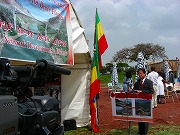|

|
|

|
| Ambassador's Speech>2011 >110712 | |||||
|
|||||
| at the Handing-over Ceremony of Equipment to Cope with Landslides in the Abay Gorge at the Ethiopian Roads Authority (ERA) Warehouse in Kality on 12 July, 2011 |  |
||||
| Your Excellency Ato Telesadik Reba, State Minister of Transport, Distinguished Guests, Ladies and Gentlemen, Endemen Aderachehu. Today, here at the Ethiopian Roads Authority (ERA) warehouse in Kality, it is a great pleasure for me to attend this handing-over ceremony of equipment to cope with landslides to the Ethiopian Government. This project is implemented, based upon the grant agreement concluded between our two Governments on 11 June, 2010. For this project, the Japanese Government extended 960 million Japanese Yen [about 203 million Ethiopian Birr at the current exchange rate] to the Ethiopian Government to procure road construction equipment needed for landslide countermeasures in the Abay Gorge. Excavators, bulldozers, motor graders, wheel loaders, compressors, dump trucks and a truck with crane are among the items purchased. As you all know, Ethiopia has been developing road transportation networks under the Road Sector Development Program (RSDP) since 1997. As part of this program, Japan played its role in the rehabilitation of the Addis-Gohatsion-Dejen Trunk Road, together with the construction of the New Abay Bridge, by extending grants, amounting to 12 billion Japanese Yen [about 2.4 billion Ethiopian Birr]. This route is an arterial road which links the granary in the north-western part of the country to the markets in the rest of Ethiopia. This route also leads to Sudan in the north and is crucial for the shipment of over 80 per cent of Ethiopia’s oil imports. On this route, however, due to the difficult geographical conditions of the gorge with its steep slopes, coupled with heavy rainfall during the rainy season, the Abay Gorge Zone has repeatedly suffered from landslides, slope failures and rock falls. From time to time, these disasters have disrupted the smooth traffic flow of this important trunk road in the gorge area. This is the reason why we decided to support ERA to address this landslide issue. The equipment, which has just been handed-over, is useful not only to clear the road whenever landslides occur but also to minimize the risk of landslides. As part of Japan’s cooperation for landslide countermeasures, JICA has already dispatched a Japanese expert on landslides to the Geological Survey of Ethiopia (GSE) and another expert to ERA. With the supply of this equipment, JICA will now start a technical cooperation project with ERA to strengthen Ethiopian capabilities to cope with landslides. Excellency, Ladies and Gentlemen, The current RSDP IV, as one of the pillars of the Growth and Transformation Plan (GTP), aims to extend the existing road networks both at the federal and regional levels from the present 49,000 km to about 64,500 km in five years. This plan, however, seems very ambitious. It will require concerted efforts by the Ethiopian Government and its development partners. Our engagement with Ethiopian road transportation development will not remain where we were in the past. We are proactive. Last month Japan concluded two grant agreements with the Ethiopian Government for the road sector, in which a total of 5.359 billion Japanese Yen [1.135 billion Ethiopian Birr] was extended. The projects to which we have committed this time are for the replacement of the Awash Bridge on the A1 Trunk Road and the rehabilitation of the Trunk Road between Dejen and Lumame. Japan, as a long standing supporter of the road sector in Ethiopia, will remain committed to assist the implementation of the RSDP IV. We are always with you. Amesegnalehu! |
|||||
|
|||||